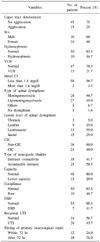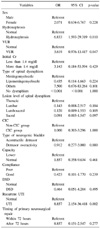Abstract
Purpose
We evaluated the risk factors for upper urinary tract deterioration in children with neurogenic bladder.
Materials and Methods
The study population consisted of 60 children (36 boys, 24 girls) with neurogenic bladder confirmed by urodynamic study between January 1994 and June 2007. The average follow-up period was 48 months. The patients' medical records were assessed concerning gender, presence of vesicoureteral reflux (VUR), hydronephrosis, type of spinal dysraphism, level of spinal dysraphism, practice of clean intermittent catheterization (CIC), type of neurogenic bladder, bladder capacity, compliance, detrusor sphincter dyssynergia, recurrent urinary tract infection (UTI), and timing of primary neurosurgical repair. Upper urinary tract deterioration was diagnosed by 99m technetium-dimercaptosuccinic acid renal scan (DMSA) and aggravation of hydronephrosis and VUR.
Results
Upper urinary tract deterioration was detected in 15 patients (25%). Hydronephrosis, VUR, and UTI were associated with upper urinary tract deterioration in the univariate analyses. In the multivariate analyses, hydronephrosis [odds ratio (OR)=2.181, 95% confidence interval (CI)=1.191-11.941, p=0.036] and recurrent UTI [OR=5.810, 95% CI=1.200-28.192, p=0.029] were independent risk factors for upper urinary tract deterioration.
Figures and Tables
References
1. Feldman AS, Bauer SB. Diagnosis and management of dysfunctional voiding. Curr Opin Pediatr. 2006. 18:139–147.
2. Ghoniem GM, Roach MB, Lewis VH, Harmon EP. The value of leak pressure and bladder compliance in the urodynamic evaluation of meningomyelocele patients. J Urol. 1990. 144:1440–1442.
3. McGuire EJ, Woodside JR, Borden TA, Weiss RM. Prognostic value of urodynamic testing in myelodysplastic patients. J Urol. 1981. 126:205–209.
4. Kaefer M, Pabby A, Kelly M, Darbey M, Bauer SB. Improved bladder function after prophylactic treatment of the high risk neurogenic bladder in newborns with myelomentingocele. J Urol. 1999. 162:1068–1071.
5. Lee SL, Park WH, Shim HB. Long-term followup of clean intermittent catheterization in spinal cord injury patients. Korean J Urol. 1997. 38:59–64.
6. Seo WK, Park CH, Kim CI, Kim KS. Long-term followup of clean intermittent catheterization in patients with neurogenic bladder. Korean J Urol. 1995. 36:645–650.
7. Wu HY, Baskin LS, Kogan BA. Neurogenic bladder dysfunction due to myelomeningocele: neonatal versus childhood treatment. J Urol. 1997. 157:2295–2297.
8. Teichman JM, Scherz HC, Kim KD, Cho DH, Packer MG, Kaplan GW. An alternative approach to myelodysplasia management: aggressive observation and prompt intervention. J Urol. 1994. 152:807–811.
9. Hjalmas K. Micturition in infants and children with normal lower urinary tract. A urodynamic study. Scand J Urol Nephrol. 1976. 37:Suppl. 1–106.
10. Holmdahl G, Hanson E, Hanson M, Hellstrom AL, Hjalmas K, Sillen U. Four-hour voiding observation in healthy infants. J Urol. 1996. 156:1809–1812.
11. Fernbach SK, Maizels M, Conway JJ. Ultrasound grading of hydronephrosis: introduction to the system used by the Society for Fetal Urology. Pediatr Radiol. 1993. 23:478–480.
12. Goldraich NP, Goldraich IH. Update on dimercaptosuccinic acid renal scanning in children with urinary tract infection. Pediatr Nephrol. 1995. 9:221–226.
13. Kim BS, Kim HT, Chung SK. Clinical course of pediatric ureteropelvic junction obstruction according to the age at diagnosis. Korean J Urol. 2007. 48:1302–1307.
14. Capitanucci ML, Iacobelli BD, Silveri M, Mosiello G, De Gennaro M. Long-term urological follow-up of occult spinal dysraphism in children. Eur J Pediatr Surg. 1996. 6:Suppl 1. 25–26.
15. Mostwin JL. Pathophysiology: the varieties of bladder overactivity. Urology. 2002. 60:Suppl 1. 22–26.
16. Ottolini MC, Shaer CM, Rushton HG, Majd M, Gonzales EC, Patel KM. Relationship of asymptomatic bacteriuria and renal scarring in children with neuropathic bladders who are practicing clean intermittent catheterization. J Pediatr. 1995. 127:368–372.
17. Silveri M, Capitanucci ML, Capozza N, Mosiello G, Silvano A, Gennaro MD. Occult spinal dysraphism: neurogenic voiding dysfunction and long-term urologic follow-up. Pediatr Surg Int. 1997. 12:148–150.
18. Vega-P JM, Pascual LA. High-pressure bladder: an underlying factor mediating renal damage in the absence of reflux? BJU Int. 2001. 87:581–584.
19. Leonardo CR, Filgueiras MF, Vasconcelos MM, Vasconcelos R, Marino VP, Pires C, et al. Risk factors for renal scarring in children and adolescents with lower urinary tract dysfunction. Pediatr Nephrol. 2007. 22:1891–1896.
20. Holland NH, Jackson EC, Kazee M, Conrad GR, Ryo UY. Relation of urinary tract infection and vesicoureteral reflux to scars: follow-up of thirty-eight patients. J Pediatr. 1990. 116:S65–S71.
21. Almodhen F, Capolicchio JP, Jednak R, El Sherbiny M. Postpubertal urodynamic and upper urinary tract changes in children with conservatively treated myelomeningocele. J Urol. 2007. 178:1479–1482.
22. Tarcan T, Onol FF, Ilker Y, Alpay H, Simsek F, Ozek M. The timing of primary neurosurgical repair significantly affects neurogenic bladder prognosis in children with myelomeningocele. J Urol. 2006. 176:1161–1165.
23. Moon KH, Lee SK, Ra YS, Kim JB, Kim KS. The change of bladder function after neurosurgery in patients with lipomyelomeningocele. Korean J Urol. 2007. 48:452–457.
24. Lee MW, Greenfield SP. Intractable high-pressure bladder in female infants with spina bifida: clinical characteristics and use of vesicostomy. Urology. 2005. 65:568–571.




 PDF
PDF ePub
ePub Citation
Citation Print
Print






 XML Download
XML Download